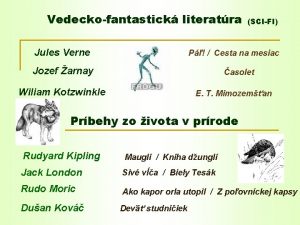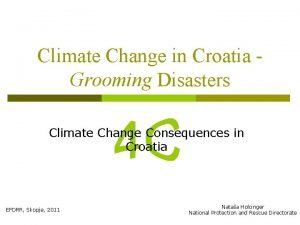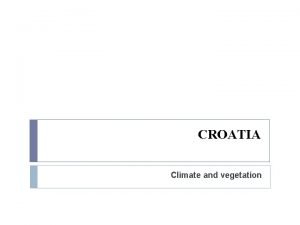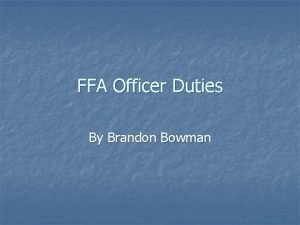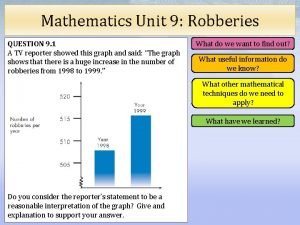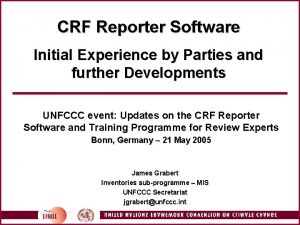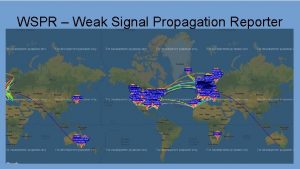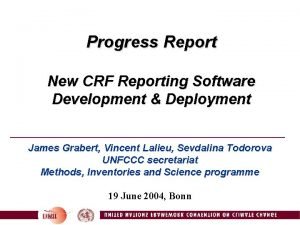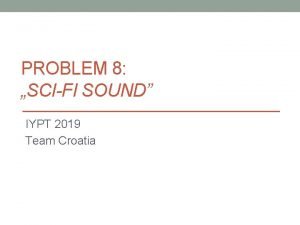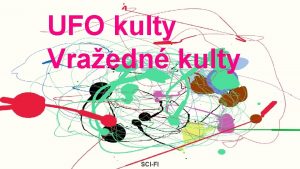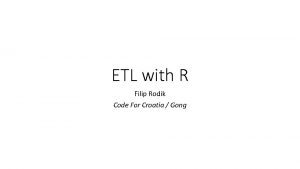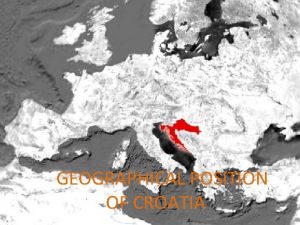8 SciFi Sound Team Croatia Reporter Filip Landek

























![References [1] P. Gash: Fundamental Slinky Oscillation Frequency using a Center-of-Mass Model [2] V. References [1] P. Gash: Fundamental Slinky Oscillation Frequency using a Center-of-Mass Model [2] V.](https://slidetodoc.com/presentation_image_h/17b6b977727403fa1053fba78dcfbe99/image-26.jpg)









- Slides: 35

8. Sci-Fi Sound Team Croatia Reporter: Filip Landek

Table of contents I • Problem description II • Theoretical model III IV V • Experiment setup • Analysis of experimental results • Conclusions and references Sci – Fi Sound – Table of contents 2

Problem description: „Tapping a helical spring can make a sound like a “laser shot” in a science-fiction movie. ” „Investigate and explain this phenomenon. ” Sci – Fi Sound – Problem description 3

Table of contents I • Problem description II • Theoretical model III IV V • Experiment setup • Analysis of experimental results • Conclusions and references Sci – Fi Sound – Table of contents 4

Bending free vibrations of Slinky wire Long thin beam free bending vibrations Euler-Bernoulli theory bending in space bending in time E – Young’s modulus ρ – density (g/cm 3) I – moment of inertia S – cross-section area Sci – Fi Sound – Theoretical model 5

Equation of acoustic dispersion Dispersion relation: bending wave angular velocity n wave n = 0, 1, 2, …, ω – angular velocity (rad/s) k – wavenumber (rad/m) E – Young’s modulus ρ – material density (g/cm 3) I – moment of inertia S – beam cross-section area Sci – Fi Sound – Theoretical model ω (rad/s) number kn k (rad/m) 6

ω (rad/s) Propagation of waves in different mediums k (rad/m) Sci – Fi Sound – Theoretical model v – phase velocity f – frequency λ – wavelenght ω – angular frequency k – wavenumber 7

Propagation of waves in different Dispersive medium Non-dispersive medium A (mm) mediums Lenght (m) Sci – Fi Sound – Theoretical model Lenght (m) 8

Initial disturbance of Slinky wire displacement w(x, t) propagating of initial w(x, t) -x x=0 Sci – Fi Sound – Theoretical model +x 9

Hypotheses 1. Dispersive medium Higher frequencies travel faster Observable time delay td 2. Time delay td will be bigger for: Longer Slinky Subsequent echoes 3. Shape of the Slinky is irrelevant Sci – Fi Sound – Theoretical model 10

Table of contents I • Problem description II • Theoretical model III IV V • Experiment setup • Analysis of experimental results • Conclusions and references Sci – Fi Sound – Table of contents 11

Experiment setup Polyurethane foam (sound isolation) Metal stand Microphone Pendulum Slinky spring Metal base Sci – Fi Sound – Experiment setup 12

Experiment setup Unstreched Slinky spring Slinky stand Sci – Fi Sound – Experiment setup 13

Experimental measurements � Qualitative analysis: � Case 1: Slinky (48 coils) � a) Clamped end – Clamped end � b) Clamped end – Free end � Case 2: Round steel wire (19 m) � a) Straight wire � b) Hand-made helical spring � Quantitative analysis: � a) Dependency frequency time delay � b) Dependency time delay echo � c) Dependency time delay number of coils Sci – Fi Sound – Experiment setup 14

Table of contents I • Problem description II • Theoretical model III IV V • Experiment setup • Analysis of experimental results • Conclusions and references Sci – Fi Sound – Table of contents 15

Frequency (Hz) Quantitative experimental proof of acoustic dispersio Sound intensity (d. B) Time (s) Sci – Fi Sound – Analysis of experimental results 16

Analysis of experimental results 1 a) The anatomy of typical sound recorded on Slinky clamped at both ends 1 II Phase 1 Intial disturbance III IV Phase II Bending waves propagation Echoes modulated wave Dampning Acoustic disperision Sci – Fi Sound – Analysis of experimental results Phase III Only low frequencies remain Phase IV Silence phase 17

Analysis of experimental results 1 b) The anatomy of typical sound recorded after hits free hanging Slinky 1 II Phase 1 Intial disturbance III IV V VII V I Phase II Bending waves propagation Echoes modulated wave Dampning Acoustic disperision Sci – Fi Sound – Analysis of experimental results Phases III & VI Secondary (internal) disturbances Phases IV & VII Silence phase 18

Sound comparison Time (s) Sci – Fi Sound – Analysis of experimental results Sound intensity (d. B) Frequency (Hz) Sound intensity (d. B) 2 b) Round wire made into a helical spring Frequency (Hz) 2 a) Straight round wire Time (s) 19

Dependence of time delay on frequency (Clamped-Clamped Slinky with 80 coils) td – time delay LSlinky – lenght of the Slinky wire vf – velocity of a frequency Sci – Fi Sound – Analysis of experimental results 20

Time delay between higher and lower frequencies in echoes td – time delay s – distance a wave has travelled vf – velocity of a frequency ne – number of echo Sci – Fi Sound – Analysis of experimental results 21

Frequency (Hz) Time delay between higher and lower frequencies in echoes Time (s) Sci – Fi Sound – Analysis of experimental results 22

Dependency of frequency delay on the number of coils Sci – Fi Sound – Analysis of experimental results 23

Table of contents I • Problem description II • Theoretical model III IV V • Experiment setup • Analysis of experimental results • Conclusions and references Sci – Fi Sound – Table of contents 24

Conclusions Theoretical model: Free flexural vibrations of a long thin beam (Euler-Bernoulli theory) Propagation of initial disturbance Acoustic dispersion Experimental results: Qualitative confirmation of theory Delay time between higher and lower frequencies Quantitative analysis close congruence to the computer simulation Dependency time delay no. of coils linear Sci – Fi Sound – Conclusions and references 25
![References 1 P Gash Fundamental Slinky Oscillation Frequency using a CenterofMass Model 2 V References [1] P. Gash: Fundamental Slinky Oscillation Frequency using a Center-of-Mass Model [2] V.](https://slidetodoc.com/presentation_image_h/17b6b977727403fa1053fba78dcfbe99/image-26.jpg)
References [1] P. Gash: Fundamental Slinky Oscillation Frequency using a Center-of-Mass Model [2] V. Henč-Bartolić, P. Kulušić: Waves and optics, School book, Zagreb, 3 rd edition (in Croatian), 2004 [3] A. Nilsson, B. Liu: Vibro-Acoustics, Vol. 1, Springer-Verlag Gmb. H, Berlin Heidelberg, 2015 [4] F. S. Crafword: Slinky whistlers, Am. J. Phys. 55(2), February 1987, p. 130 -134 [5] F. S. Crafword: Waves, Berkeley Physics Course, Vol. 3, Berkely, 1968 [6] W. C. Elmore, M. A. Heald: Physics of waves, Mc. Graw-Hill Book Company, New York, [7] J. G. Guyader: Vibration in continuous media, ISTE Ltd, London, 2002 [8] G. C. King: Vibrations and waves, John Wiley & Sons Ltd, London, 2009 [9] Th. D. Rossing, N. H. , Fletcher: Principles of vibration and sounds, Springer-Verlag New York, lnc. , 2004 [10] L. E. Kinsle et. all: Fundamentals of Acoustics, 4 th ed. , John Willey & Sons, Inc, New York, 2000 [11] M. Géradin, D. J. Rixen: Mechanical Vibrations: Theory and Application to Structural Dynamics, 3 rd ed. , John Wiley & Sons, Ltd, Chichester, 2015 [12] C. Y. Wang , C. M. Wang: Structural Vibration - Exact Solutions for Strings, Membranes, Beams, and Plates, CRC Press. Taylor & Francis Group, Boca Raton, 2014 [13] A. Brandt: Noise and vibration analysis : signal analysis and experimental procedures, John Wiley & Sons Ltd, Chichester, 2011 [14]F. S. Crawford, Jr. : Waves – Berkeley Physics Course Volume 3, Education Development Centre, 1965 [15] L. E. Kinsler, A. R. Frey, A. B. Coppens, and A. V. Sanders, Fundamentals of Acoustics, John Wiley Sci – Fi Sound – Conclusions and references 26 New York, 2000

Thank you for your attention! 27

28

Free hanging Slinky parametars Coil displacement Centre of mass

Wave equation derivation 1) II)

n = 0, 1, 2, …, r. S … the radius of gyration of beam cross-section (m) c. S … the phase velocity of a particular point in a beam material (m/s) kn … the wave number of nth bending wave I … the rotational inertia moment of a beam’s cross-section surface Low frequency bending movement 31 of a beam cross-sections [7] S … area of a beam cross-section surface (m 2) n … the nth eigencircular frequency of a bending beam (rad/s)

Bending at high and low frequencies Low frequency vibrations � High frequency vibrations ω – angular frequency E – Young’s modulus ρ – density I – moment of inertia S – cross-section area k - wavenumber

Ad. 2. For high frequency waves, the beam deflection is completely determined by transversal and longitudinal waves and the dispersion and phase velocity relations showed non dispersive behaviour of the beam cross-section [11]. or n = 0, 1, 2, …, Due to dispersion effect the lower frequencies had been recorded, and heard, with delayed time after high frequencies. High frequency transverse and quasi-longitudinal movement of a beam cross-sections [3, 7] 33

Dependency of frequency delay on the number of coils Sci – Fi Sound – Analysis of experimental results 34

Mathematically modelling of wave damping and emitted sound For both modeled cases the time function gn(t) is builded from a harmonic and vanishing wave subfunctions [3]: In the acoustic consideration the Slinky wire is modeled as . . the wave loss factor continuous line sound source under transversal oscillations. Each segment of line ( x) is an unbaffled simple source which generate the increment of sound pressure level (SPL) in the air [10]. 35 The far field acoustic field at point p(r, , t) produced by line source of length L and radius a [10]
 What are the 7 elements of science fiction
What are the 7 elements of science fiction Znaky scifi
Znaky scifi What is sciencefiction
What is sciencefiction Jules verne scifi
Jules verne scifi Herzegovina bulgaria croatia
Herzegovina bulgaria croatia Croatia osiguranje prijenos bonusa
Croatia osiguranje prijenos bonusa Croatia koppen climate
Croatia koppen climate Ministry of agriculture croatia
Ministry of agriculture croatia Longest river in croatia
Longest river in croatia Ministry of agriculture croatia
Ministry of agriculture croatia Soc croatia
Soc croatia Croatia minimum wage
Croatia minimum wage Carnival croatia
Carnival croatia Rwe
Rwe Rx
Rx Ehat is sound
Ehat is sound “a sound mind is in a sound body”
“a sound mind is in a sound body” The white team cheers for the blue team, just like
The white team cheers for the blue team, just like Bureaucratic bypass syndrome
Bureaucratic bypass syndrome Team spirit becomes team infatuation
Team spirit becomes team infatuation Nyscr
Nyscr Ffa officers duties
Ffa officers duties Blue coat reporter
Blue coat reporter Ffa chaplain symbol
Ffa chaplain symbol Ypqa
Ypqa Pa child abuse
Pa child abuse Mandated reporter louisiana
Mandated reporter louisiana Mandatory reporting alabama
Mandatory reporting alabama A tv reporter showed this graph and said
A tv reporter showed this graph and said Michigan cps 3200
Michigan cps 3200 N-reporter
N-reporter Brothers convince little sister of zombie apocalypse
Brothers convince little sister of zombie apocalypse Crf reporter
Crf reporter National reporter system
National reporter system Wspr download
Wspr download Crf reporter
Crf reporter



